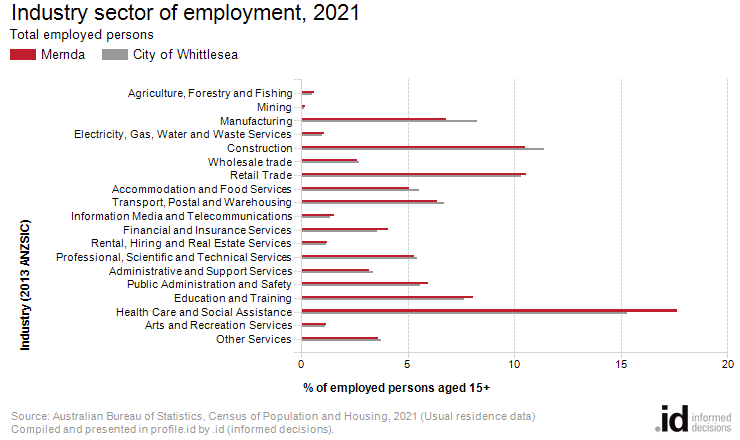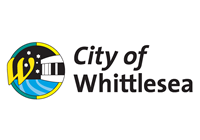Mernda
Industry sector of employment
More Mernda residents worked in health care and social assistance than any other industry in 2021.
Mernda's industry statistics identify the industry sectors in which the residents work (which may be within the residing area or elsewhere). This will be influenced by the skill base and socio-economic status of the residents as well as the industries and employment opportunities present in the region.
When viewed in conjunction with Residents Place of Work data and Method of Travel to Work, industry sector statistics provide insights into the relationship between the economic and residential role of the area.
Derived from the two Census questions:
'What best describes the business of your employer?' and 'What are the main goods produced or main services provided by your employers business?'
Employed persons aged 15 years and over
| Industry sector of employment | ||||||||
|---|---|---|---|---|---|---|---|---|
| Mernda - Employed persons (Usual residence) | 2021 | 2016 | Change | |||||
| Industry sector | Number | % | City of Whittlesea % | Number | % | City of Whittlesea % | 2016 to 2021 | |
| Agriculture, Forestry and Fishing | 70 | 0.6 | 0.5 | 56 | 0.7 | 0.6 | +14 | 14001 |
| Mining | 21 | 0.2 | 0.2 | 14 | 0.2 | 0.1 | +7 | 14002 |
| Manufacturing | 776 | 6.8 | 8.2 | 615 | 7.8 | 9.5 | +161 | 14003 |
| Electricity, Gas, Water and Waste Services | 125 | 1.1 | 1.0 | 135 | 1.7 | 1.2 | -10 | 14004 |
| Construction | 1,199 | 10.5 | 11.4 | 872 | 11.0 | 10.2 | +327 | 14005 |
| Wholesale trade | 299 | 2.6 | 2.7 | 250 | 3.2 | 3.2 | +49 | 14006 |
| Retail Trade | 1,206 | 10.6 | 10.3 | 920 | 11.6 | 11.5 | +286 | 14007 |
| Accommodation and Food Services | 578 | 5.1 | 5.6 | 368 | 4.7 | 5.9 | +210 | 14008 |
| Transport, Postal and Warehousing | 730 | 6.4 | 6.7 | 485 | 6.1 | 7.0 | +245 | 14009 |
| Information Media and Telecommunications | 179 | 1.6 | 1.3 | 116 | 1.5 | 1.5 | +63 | 14010 |
| Financial and Insurance Services | 464 | 4.1 | 3.6 | 294 | 3.7 | 3.5 | +170 | 14011 |
| Rental, Hiring and Real Estate Services | 137 | 1.2 | 1.2 | 108 | 1.4 | 1.3 | +29 | 14012 |
| Professional, Scientific and Technical Services | 607 | 5.3 | 5.5 | 404 | 5.1 | 4.9 | +203 | 14013 |
| Administrative and Support Services | 366 | 3.2 | 3.4 | 296 | 3.7 | 3.7 | +70 | 14014 |
| Public Administration and Safety | 680 | 6.0 | 5.6 | 483 | 6.1 | 5.2 | +197 | 14015 |
| Education and Training | 922 | 8.1 | 7.7 | 603 | 7.6 | 7.0 | +319 | 14016 |
| Health Care and Social Assistance | 2,010 | 17.6 | 15.3 | 1,161 | 14.7 | 12.9 | +849 | 14017 |
| Arts and Recreation Services | 134 | 1.2 | 1.1 | 97 | 1.2 | 1.2 | +37 | 14018 |
| Other Services | 412 | 3.6 | 3.8 | 299 | 3.8 | 4.0 | +113 | 14019 |
| Inadequately described or not stated | 495 | 4.3 | 5.1 | 324 | 4.1 | 5.6 | +171 | 14020 |
| Total employed persons aged 15+ | 11,410 | 100.0 | 100.0 | 7,900 | 100.0 | 100.0 | +3,510 | |
Source: Australian Bureau of Statistics, Census of Population and Housing (opens a new window) 2016 and 2021. Compiled and presented by .id (opens a new window)(informed decisions).
(Usual residence data)

Compiled and presented in profile.id by .id (informed decisions).

Compiled and presented in profile.id by .id (informed decisions).
Dominant groups
An analysis of the jobs held by the resident population in Mernda in 2021 shows the three most popular industry sectors were:
- Health Care and Social Assistance (2,010 people or 17.6%)
- Retail Trade (1,206 people or 10.6%)
- Construction (1,199 people or 10.5%)
In combination, these three industries employed 4,415 people in total or 38.7% of the total employed resident population.
In comparison, the City of Whittlesea employed 15.3% in Health Care and Social Assistance; 10.3% in Retail Trade; and 11.4% in Construction.
The major differences between the jobs held by the population of Mernda and the City of Whittlesea were:
- A larger percentage of persons employed in health care and social assistance (17.6% compared to 15.3%)
- A smaller percentage of persons employed in manufacturing (6.8% compared to 8.2%)
Emerging groups
The number of employed people in Mernda increased by 3,510 between 2016 and 2021.
The largest changes in the jobs held by the resident population between 2016 and 2021 in Mernda were for those employed in:
- Health Care and Social Assistance (+849 persons)
- Construction (+327 persons)
- Education and Training (+319 persons)
- Retail Trade (+286 persons)
